Acacia laeta
Localisation of Acacia laeta in South Africa.
In Sekhukhuneland as well as further north in Limpopo province, about 150 km south of the border to Zimbabwe, we encountered plants that have a resemblance to A. mellifera, but have more pairs of pinnae and more leaflet pairs per pinna than A. mellifera. It also sometimes shows three hooks at the nodes, all three directed upwards.
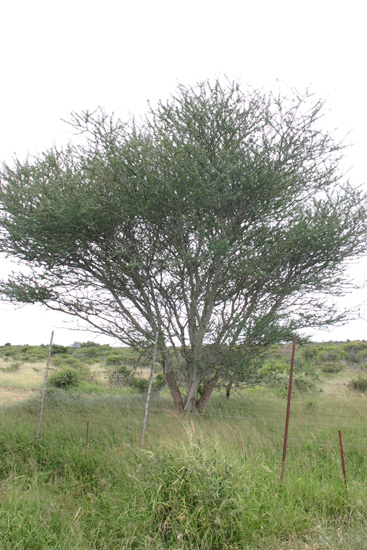
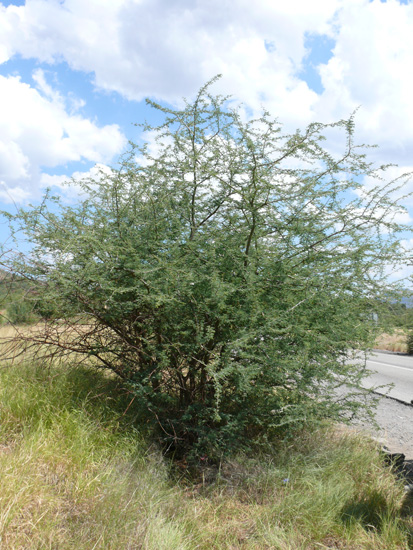
Tree in Limpopo province. A. laeta in Sekhukhuneland
In the area also occur A. leihorachis and A. mellifera
The question was raised, if these poulations represent a southern occurance of A. laeta.
If you search for Acacia laeta in Google there are more than 16.000 links. That means that A. laeta is a well known, widely distributed and heavily cited plant. It has, however, not been described as occurring in South Africa.
In Ross (1979) p.67, A. laeta is treated as a separate species. A study of Elamin is cited , which indicated, that the species is morphologically intermediate between A. mellifera and A. senegal and is certainly of hybrid origin, a view which confirms earlier suggestions of Brennan in F.T.E.A.: 83 (1959) and other authors. Both A. mellifera and A. senegal have a diploid chromosome of 2n=26, while in A. laeta 2n=39. The pollen grains in A. mellifera and A. senegal are similar and consist of 16-celled polyads, but in A. laeta the polyads are 18to20- celled. Elamin found that A. laeta appeared to be more closely related to A. mellifera than to A. senegal and suggested that this is probably due to back crossing with A. mellifera in the past. The seedling development of A. laeta is the same as in A. mellifera, but different from that of A. senegal. (1)
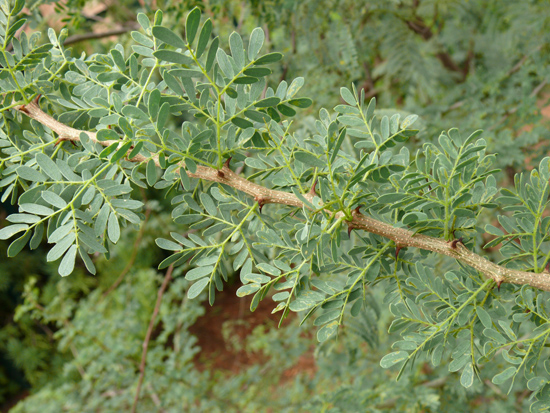
Bot. Garden Nelspruit, 5.2.07; 2nd. Generation (Plant grown from seeds of
A. laeta in Sekhukhuneland) has more leaflets than the examind leaf described below.
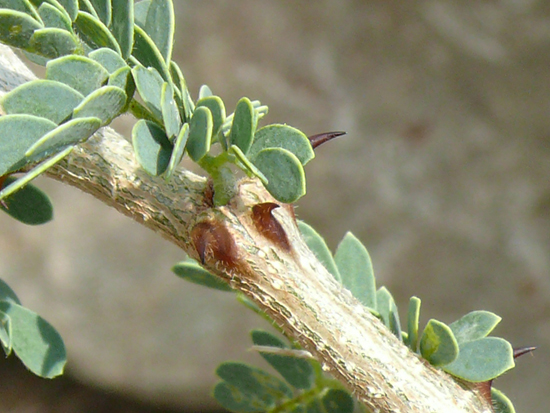
Same plant as above showing three hook thorns looking in the same
In C. Campa et. al (1998), p.299, it is stated that the zymogrammes of A. laeta are resulting from a juxtaposition of the isoenzymes of A. senegal and A. mellifera. That means that A. laeta has a fixed heterozygoty, which strengthens the hypothesis that A. laeta is an interspecific hybrid between A. mellifera and A. senegal. (2)
Formerly that plant had only been observed north of northern Tanzania. The A. senegal parent always was A.senegal var. senegal.
Further south in Africa A. senegal var. rostrata and A. senegal var. leihorachis are found.
In the Field Guide to the acacias of Zimbabwe (1999) p.86, a plant is described that could be also A. laeta. It is found in the Southwestern border along the Limpopo river, not very far from our A. laeta population. It seems to be a hybrid between A. mellifera and A. senegal and is very close to A. mellifera, but also has some characteristics of A. senegal. Both taxa, A. senegal var. rostrata and A. senegal var. leihorachis occur in that area (which leads J. Hurter to the conclusion, that A.senegal var. rostrata and A. leihorachis should be two different species). As A. senegal var. rostrata flowers much later than A. mellifera and A. senegal var. leihorachis flowers at the same time with A. mellifera, “A. laeta” (brackets are given in original literature!) is considered a hybrid between A. mellifera and A. leihorachis (3).
Sample examined in Sekhukhuneland, Jan 30st.,2007:
Leaf is 2,5 cm long, thereof 0,8 cm petiole. On petiole cupula-formed gland at 0,24, cm from base. 3 pairs of pinnae. 1st feather: 2 leaflet pairs , 2nd and 3rd feather: 3 leaflet pairs. No glands on rachis.
Leaflets 1cm long, 0,5 cm wide, main vein slightly asymmetric, small tip. Side veins clearly visible. Petiole, rachis and leaflets showing some small white hairs.
2 hook thorns, occasionally three, all showing in the same direction (different from hook positioning in A. senegal.). In one case ( see photo below) we even found 5 hooks at a node (or were there two nodes very close together?).
J. Hurter has observed in former years, that the flowers have a pinkish tint.
In the Field Guide to Acacias of East Africa (2006) p.97, the author states that she has found both creamish white or bright pink flowers, sometimes both.
Seeds from the plants in Sekhukhuneland (GPS-readings: S: 24.87234, E: 030.04547, altitude: 828m) have been raised in Nelspruit Lowveld Botanical Garden by J. Hurter. Several plants are now growing in the garden, showing all the same habitus and the same taxonomic features like the plants in Sekhukhuneland.
Comparing the features of A. laeta from the literature with our observations, there is no obvious difference between A. laeta as occurring in the Sahel countries and the taxa seen in South Africa.
More data for this article should include:
- an enzyme analysis
- a detailed description of the taxonomic features
- a picture of the pinkish flowers
- the chromosome count
Depending on the outcome of the enzyme analysis, we could add the described (new) taxa to the species A. laeta or speak of the “old” A. laeta as A. laeta var. senegal and our samples as A. laeta var. leihorachis.
Sample showing 5 hooks at node!

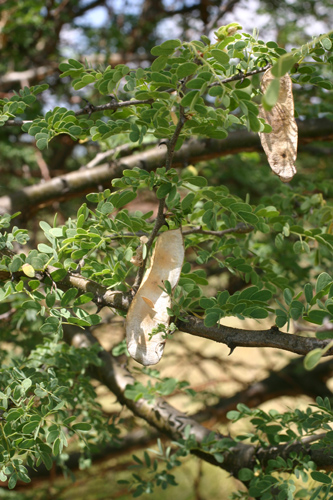
Dry pods in A. laeta var. leihorachis
Detailed literature citations are found here
1.3.08
